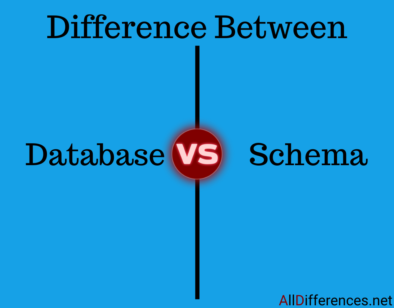Comparison between Database And Schema
Contents
- The Key Difference Between Database And Schema is that Database is a collection of interrelated data whereas Schema is a structural view of a database.
- A database is a collection of data that is organized so that it can be easily accessed, managed, and updated. A schema is a blueprint for a database that defines the structure of the data, including the names of the tables, columns, and their data types.

Comparison Chart
- Here is a table that summarizes the key differences between a database and a schema:
| Database | Schema |
|---|---|
| Database is a collection of related records and data stored in tables. | Schema is a logical representation of a database. |
| Database is updating the data regularly so that it can change frequently | Schema once declared should not be modified frequently. |
| DML statement adds, updates the records (data) in a database. | DDL statements specify a schema for a database. |
| Database is a collection of schema, records, and constraints for the tables | Schema always included the name of the tables, columns name, their types, and constraints |
Definition of Database
A database is a structured collection of data that is organized, managed, and accessed through a software system. It serves as a repository for storing and retrieving data in a consistent and structured manner. Databases can store various types of data, including text, numbers, images, and multimedia files. They are designed to handle large volumes of data efficiently and provide mechanisms for data integrity, security, and scalability.
Components of a Database
A typical database consists of several components, including tables, relationships, indexes, queries, and security mechanisms. These elements work together to ensure data integrity and facilitate data retrieval and manipulation.
Tables: Tables are the building blocks of a database. They represent entities or concepts and store data in rows and columns.
Relationships: Relationships define the connections between tables and enable the establishment of meaningful associations between data entities.
Indexes: Indexes are data structures that enhance data retrieval speed by creating optimized paths for accessing specific data subsets.
Queries: Queries allow users to retrieve, manipulate, and analyze data from the database using structured query languages like SQL.
Security: Database security measures protect sensitive data from unauthorized access, ensuring data privacy and compliance with regulations.
Definition of Schema
A schema, on the other hand, is a logical container or blueprint that defines the structure, organization, and constraints of a database. It provides a framework for organizing data elements, specifying data types, and enforcing data integrity rules.
Purpose of Schema
The primary purpose of a schema is to define the logical structure and relationships within a database. It acts as a blueprint that guides the creation and management of database objects, such as tables, views, procedures, and functions. The schema ensures consistency and coherence in data storage, enabling efficient data retrieval and manipulation.
Schema in Relational Databases
In the context of relational databases, a schema is synonymous with the structure of the database itself. It defines the tables, their columns, data types, relationships, and constraints. Relational database management systems (RDBMS) enforce the schema to maintain data integrity and enforce relationships between entities.
Schema in NoSQL Databases
In the realm of NoSQL databases, the concept of a schema is more flexible. NoSQL databases, such as document-oriented or key-value stores, do not strictly enforce a predefined schema. NoSQL databases allow for schema flexibility, allowing developers to store data with varying structures within the same database. This flexibility is particularly beneficial in scenarios where the data model is evolving or where different types of data need to be stored together.
Conclusion
In conclusion, while databases and schemas are closely related, they serve different purposes in the realm of data management. A database represents a structured collection of data, while a schema defines the structure and organization of specific objects within a database. Understanding the differences between databases and schemas is essential for effective database design and management, ultimately leading to efficient data retrieval, manipulation, and scalability.
FAQs
- What is the role of a database administrator? A database administrator is responsible for the management, maintenance, and security of a database. They handle tasks such as performance tuning, data backup and recovery, user access management, and database schema design.
- Can a database have multiple schemas? Yes, a database can have multiple schemas. Schemas provide a way to organize and group related objects within a database, allowing for better data management and access control.
- Can a schema exist without a database? No, a schema cannot exist without a database. A schema is a logical container that resides within a database and defines the structure and organization of specific objects within that database.
